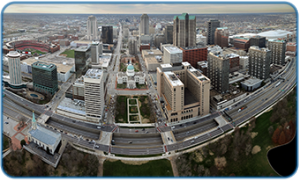Managing a Complex System

With over 9,600 miles of pipeline serving an area over 520-square miles large, the St. Louis Metropolitan Sewer District (MSD) is the fourth-largest sewer system in the United States. Our seven wastewater treatment facilities process an average of 350 million gallons of sewage every day.
St. Louis City and its older, inner suburbs are served by combined sewers, or pipes that carry both wastewater and stormwater. We also serve 87% of St. Louis County, where separate sanitary and stormwater sewers predominate. Unlike wastewater, stormwater does not need to be treated so it can bypass MSD’s wastewater treatment plants and be discharged into the natural streams that play a vital role in stormwater removal.
The City’s combined sewers are some of the oldest in the country—giant, subterranean, brick tunnels running beneath our historic neighborhoods and downtown. During wet weather, especially heavy rains, the volume of the combined sewage and rainwater can overwhelm the capacity of our sewers, causing a mixture of sewage and rainwater to bypass the treatment facility and discharge directly into local rivers. Known as Combined Sewer Overflows (CSOs), these events increase the level of pollutants and disease-causing pathogens (viruses, bacteria, and parasites) in our rivers. Wet weather events can overwhelm sewers in a neighborhood, causing wastewater and rainwater to backup in basements, a distressing situation for residents and business owners.
In the separate system common throughout our St. Louis County service area, sanitary sewers carry wastewater from sinks, dishwashers, showers, and toilets. Stormwater should be absorbed back into the ground or carried to a nearby creek through stormwater sewers or natural drainage paths. Sanitary sewers were designed to carry the anticipated volume of wastewater produced in its service area. But population growth and new construction can overwhelm system capacity. If the pipes are not routinely cleaned and maintained, blockages and cracks can develop that allow stormwater to leak into the wastewater system. If the combined water exceeds the pipes’ capacity, basement sewer backups can happen and excess wastewater can be discharged into local streams, making an unsafe environment for fish, aquatic life, and humans.
Adding to the challenge, many structures in our City service area connect stormwater removal systems like rain gutters, sump pumps, and yard drains directly into the wastewater sewer system. With the help of local home and business owners, MSD’s Get the Rain Out initiative seeks to re-route these connections to the stormwater sewer system.

